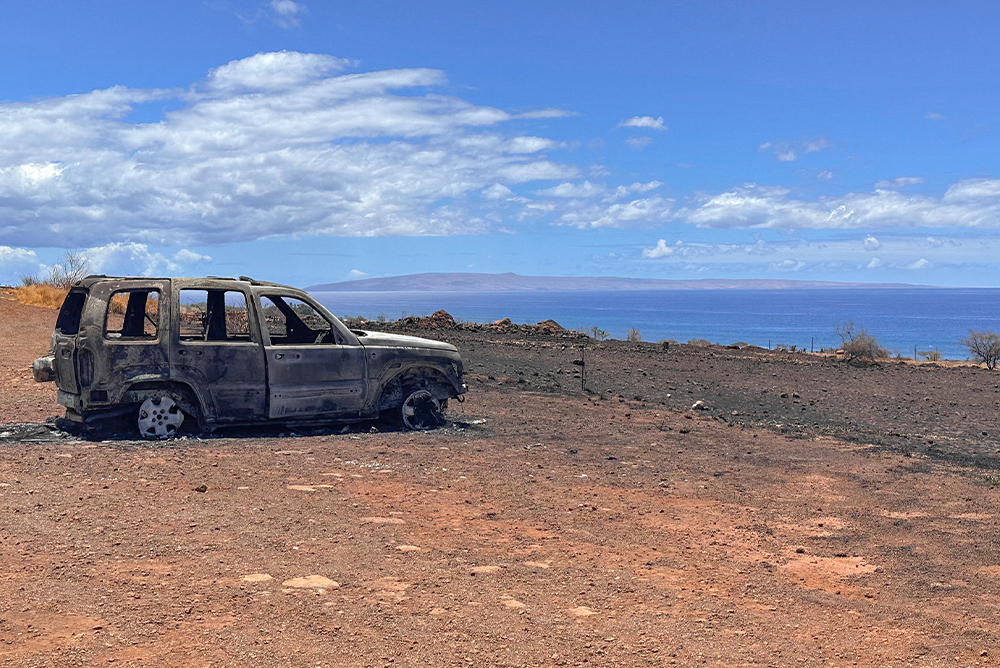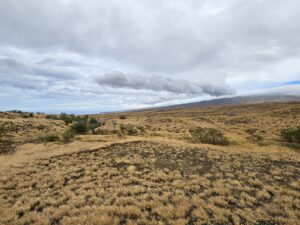
A view of the damage from fires in Maui. Meteorologist Michael Phillips, who lives on Hawai’i’s Big Island, explains what makes his home both a paradise and a dangerous place. Courtesy of State Farm/Flickr (CC BY 2.0).
Hawai‘i is a spectacular place—not just visually exciting, but also located above incredible geological forces and beneath amazing atmospheric conditions. As a meteorologist who reports on earth science news, I call the Aloha State home because of the multiple scientific processes that come together here every day to create a true paradise.
The casual joke shared among locals is that we live on an island that is actively trying to kill us. Hawai‘i has a long history of epic natural disasters and will be a home for earthquakes, tsunamis, flash floods, hurricanes, and volcanic eruptions for thousands of years to come. But the wildfire tragedy on August 8 on Maui has turned the joke on its head, leaving my neighbors and me to wonder whether it’s more than just nature that doesn’t have our best interests at heart. Why don’t leaders take better advantage of our vast scientific knowledge to prevent future catastrophes?
I live in Waikoloa Village on the Big Island of Hawai‘i’s west coast, which the Hawai‘i Wildfire Management Organization declared one of the communities most at-risk of fire in the state. Here, down-sloping, east-to-west trade winds tend to warm and dry the air, leading to an abundance of warm sunny days year-round. But when the atmospheric pattern is just right over the Pacific, as was the case when Hurricane Dora passed well south of Hawai‘i on August 7, 8, and 9, those winds can be fierce, potentially damaging, and extraordinarily dry. The same is true for many other leeward (downwind) communities in Hawai‘i in the shadows of old volcanic mountains that blunt most precipitation away to the windward (wind-facing) side.
Waikoloa Village, a community of about 7,400 people sitting about 900 feet above sea level, is also uniquely situated on ancient lava flows from two volcanoes. Over time, invasive grasses introduced by ranchers and landscapers have spread on what was once a completely barren landscape, coming to life in infrequent rainy periods, and going dormant or dead for most of the year.
The community is packed tightly together in a mix of one- or two-story homes of wooden frame construction, with larger parcels and condominium complexes here and there. It is essentially a giant cul-de-sac, with a single road leading in and out. During a 2021 evacuation event in which fire threatened the village, many were trapped in traffic for hours. Fire fighters successfully fought that battle, but we cannot rest peacefully knowing they may not prevail next time.
Maui’s Lahaina, like Waikoloa Village, had previous experience with wildfire threats. Yet in both places, there have been few policy changes or necessary investments in recent years: no substantial changes to building codes, evacuation programs, communication systems, or land use issues where flammable invasive vegetation runs rampant. Many utility lines, including several that run on poles through the grassy regions upwind of Waikoloa Village, remain exposed to the elements, as was the case in Lahaina, where electrical sparks ignited the recent tragedy there. On Hawai‘i Island, government officials make promises for Waikoloa Village, but have done little beyond permitting new construction and inviting in new residents. Commitments and deadlines to install emergency sirens, roadway improvements like traffic lights, and the construction of new roadways to improve evacuation routes come and go with the regularity of the trade winds.
There is a sincere sense of loss in our state after the August 8 fires. But in addition to missing hundreds of people, we’re also missing out on a sense of urgency, purpose, and intent to prevent the next disaster. This is inexcusable, in part because we have the forecasting technology and knowledge to make better broad policy decisions as well as to sound the alarm in advance of specific events, like the August 8 fire, as well as broader threats, like the current drought.
We are currently in the midst of ENSO, El Niño-Southern Oscillation, a recurring climate pattern involving changes in the temperature of waters in the central and eastern tropical Pacific Ocean. Over an ENSO period ranging from about three to seven years, the surface waters across a large swath of the tropical Pacific Ocean warm or cool by anywhere from 1°C to 3°C, compared to normal. This oscillating warming and cooling pattern directly affects rainfall distribution in the tropics and can have a strong influence on weather across the United States and other parts of the world. El Niño and La Niña are the extreme phases of the ENSO cycle; between these two phases is a third phase called ENSO-neutral.
While these phenomena impact the entire United States, Hawai‘i may find itself particularly vulnerable to bad weather this year, as a wet La Niña fades and a dry El Niño arrives. In May, Kevin Kodama, hydrologist at the Honolulu office of the National Weather Service, shared their 2022-2023 Wet Season Rainfall Summary. According to Kodama, the October–April wet season in Hawai‘i was an unusual one, starting off with severe or extreme drought in portions of all four of Hawai‘i’s counties, which gave way to the state’s ninth wettest wet season over the last 30 years. The Big Island saw the most rain, with rainfalls recorded at 130–170% of average.
Now, the National Weather Service is predicting an active 2023 hurricane season combined with severe drought by the end of dry season in October. Drought is most likely in the leeward areas, especially in Maui County and the Big Island—the two islands that saw fires break out on August 8. The bumper crop of invasive grass and scrub that blossomed earlier in the wet season is becoming a wasteland of drying fire fuels.
The forecast is crystal clear: Meteorological ingredients will conspire for ripe fire weather conditions in the months ahead. More lives could be at risk. And even as it is so obvious to forecasters and the public at large that more disasters are coming, the outlook on what the government will do, if anything, is cloudy at best.
Thus far, rather than capitalize on the loss, the media attention, and the tremendous amount of federal aid coming in, leaders here are digging their heads into the sand, doing what they did ahead of the Lahaina fire: hoping that disaster doesn’t happen. And because of that, the aloha spirit is being severely challenged, allowing a fog of anxiety and anger to rise. For this meteorologist, the overall outlook for Hawai‘i isn’t as sunny as it should be.





Send A Letter To the Editors